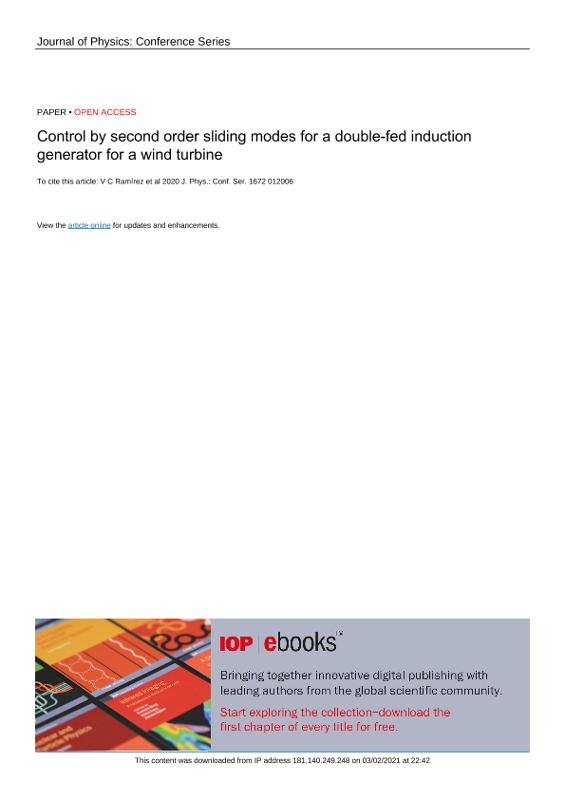Mostrar el registro sencillo del ítem
Control by second order sliding modes for a double-fed induction generator for a wind turbine
| dc.contributor.author | Ramírez, V C | |
| dc.contributor.author | González Granada, J R | |
| dc.contributor.author | Montoya, O D | |
| dc.date.accessioned | 2021-02-08T16:15:57Z | |
| dc.date.available | 2021-02-08T16:15:57Z | |
| dc.date.issued | 2020 | |
| dc.date.submitted | 2021-02-08 | |
| dc.identifier.citation | B. Beltran, M. E. H. Benbouzid and T. Ahmed-Ali, "Second-Order Sliding Mode Control of a Doubly Fed Induction Generator Driven Wind Turbine," in IEEE Transactions on Energy Conversion, vol. 27, no. 2, pp. 261-269, June 2012, doi: 10.1109/TEC.2011.2181515. | spa |
| dc.identifier.uri | https://hdl.handle.net/20.500.12585/9952 | |
| dc.description.abstract | In recent years, the consumption of electrical energy in the world has increased, increasing the construction of power plants that operate with fossil fuels, which emit a large amount of CO2. Due to this polluting process, it is important to generate efficient alternatives. In this work the model of the double-feed induction generator for a wind turbine is exposed, to which the control by second order sliding modes will be applied to its state variables and these results will be compared with the classic proportional-integral-derivative technique of control. In this work it was found that the responses of the system with a second order sliding mode control compared to a control of the proportional-integral-derivative type, have a shorter establishment time and a slower behavior over time; in some cases the waveforms of the signals have a vibration effect at the moment of the response, but despite this, the response is not affected due to the wind speed to which the turbine is subjected, and reduces quickly system error at any instant of time. Whereas with a proportional-integral-derivative controller, some state variables can be highly dependent on wind speed. | spa |
| dc.format.extent | 8 páginas | |
| dc.format.mimetype | application/pdf | spa |
| dc.language.iso | eng | spa |
| dc.rights.uri | http://creativecommons.org/licenses/by-nc-nd/4.0/ | * |
| dc.source | Journal of Physics: Conference Series, Volume 1672, | spa |
| dc.title | Control by second order sliding modes for a double-fed induction generator for a wind turbine | spa |
| dcterms.bibliographicCitation | Muller S, Deicke M, De Doncker R 2002 Doubly fed induction generator systems for wind turbines IEEE Industry Applications Magazine 8(3) 26 | spa |
| dcterms.bibliographicCitation | Jabir M, Azil H, Raza S, Mokhlis H 2017 Intermittent smoothing approaches for wind power output: A review Energies 10 1 | spa |
| dcterms.bibliographicCitation | Sabanovic A 2011 Variable structure systems with sliding modes in motion control - a survey IEEE Transactions on Industrial Informatics 7(2) 212 | spa |
| dcterms.bibliographicCitation | Levant A 2006 Principles of 2-sliding mode design Automatica 43(4) 576 | spa |
| dcterms.bibliographicCitation | Evangelista C A, Valenciaga F, Puleston P F 2011 Multivariable 2-sliding mode control for a wind energy system based on a double fed induction generator International Journal of Hydrogen Energy 37(13) 10070 | spa |
| dcterms.bibliographicCitation | Martinez M, Tapia G, Susperregui A, Camblong H 2012 Sliding- mode control for DFIG rotor- and gridside converters under unbalanced and harmonically distorted grid voltage IEEE Transactions on Energy Conversion 27(2) 328 | spa |
| dcterms.bibliographicCitation | Moreno J, Osorio M 2008 A Lyapunov approach to second-order sliding mode controllers and observers 47th IEEE Conference on Decision and Control CDC (México: IEEE) | spa |
| dcterms.bibliographicCitation | Pena R, Clare J C, Asher G M 1996 Doubly fed induction generator using back-to-back PWM converters and its application to variable-speed wind energy generation IEE Proceedings - Electric Power Applications 143 (3) 231 | spa |
| dcterms.bibliographicCitation | Benbouzid M, Beltran B, Amirat Y, Yao G, Han J, Mangel H 2014 Second-order sliding mode control for DFIG-based wind turbines fault ride-through capability enhancement ISA Transactions 53(3) 827 | spa |
| dcterms.bibliographicCitation | Beltran B, Benbouzid M E H, Ahmed-Ali T 2012 Second-order sliding mode control of a doubly fed induction generator driven wind turbine IEEE Transactions on Energy Conversion 27(2) 261 | spa |
| dcterms.bibliographicCitation | Giraldo D, Tabares I 1996 El problema de seguimiento en modo deslizante Scientia Et Technica 4 44 | spa |
| dcterms.bibliographicCitation | Shang L, Hu J 2012 Sliding-Mode-based direct power control of grid-connected wind-turbine-driven doubly fed induction generators under unbalanced grid voltage conditions IEEE Transactions on Energy Conversion 27(2) 362 | spa |
| datacite.rights | http://purl.org/coar/access_right/c_abf2 | spa |
| oaire.version | http://purl.org/coar/version/c_970fb48d4fbd8a85 | spa |
| dc.identifier.url | https://iopscience.iop.org/article/10.1088/1742-6596/1672/1/012006 | |
| dc.type.driver | info:eu-repo/semantics/lecture | spa |
| dc.type.hasversion | info:eu-repo/semantics/publishedVersion | spa |
| dc.identifier.doi | 10.1088/1742-6596/1672/1/012006 | |
| dc.subject.keywords | Asynchronous generators | spa |
| dc.subject.keywords | Fossil fuel power plants | spa |
| dc.subject.keywords | Fossil fuels | spa |
| dc.subject.keywords | Proportional control systems | spa |
| dc.subject.keywords | Sliding mode control | spa |
| dc.subject.keywords | Two term control systems | spa |
| dc.subject.keywords | WindWind turbines | spa |
| dc.rights.accessrights | info:eu-repo/semantics/openAccess | spa |
| dc.rights.cc | Attribution-NonCommercial-NoDerivatives 4.0 Internacional | * |
| dc.identifier.instname | Universidad Tecnológica de Bolívar | spa |
| dc.identifier.reponame | Repositorio Universidad Tecnológica de Bolívar | spa |
| dc.publisher.place | Cartagena de Indias | spa |
| dc.subject.armarc | LEMB | |
| dc.type.spa | http://purl.org/coar/resource_type/c_8544 | spa |
| dc.audience | Investigadores | spa |
| oaire.resourcetype | http://purl.org/coar/resource_type/c_c94f | spa |
Ficheros en el ítem
Este ítem aparece en la(s) siguiente(s) colección(ones)
-
Productos de investigación [1453]
Universidad Tecnológica de Bolívar - 2017 Institución de Educación Superior sujeta a inspección y vigilancia por el Ministerio de Educación Nacional. Resolución No 961 del 26 de octubre de 1970 a través de la cual la Gobernación de Bolívar otorga la Personería Jurídica a la Universidad Tecnológica de Bolívar.













